Outline of ProgrammeX
| 3. The Role of ICT in the 21st Century |
3.2 From IT to ICT3.1 The Impact of ICT within Organisations

The role of ICT in our business and society in the 21st Century will be in many aspects different from the current role of IT. The digitalisation of communication technology and consumer electronics makes it possible to integrate these technologies with information technology. The most important consequences of this integration are:
- Current IT systems like mainframes and PCs and even client-server systems are stand-alone systems designed for the support of one company, user or organisational unit. These systems are not designed for collaboration with other systems.
- ICT systems are networked systems. All current corporate and private IT systems will become a node in world-wide network based on the Internet or the successor of the Internet and must collaborate with each other through the network.
- Current information systems are oriented on data processing and the storage and retrieval of information.
- ICT will also support the communication and co-operation of human beings and their organisations and the creation and exchange of knowledge.
- Current information systems support the internal organisation of the company. IT is used for enhancing efficiency and the support of mass-production of uniform products and services.
- ICT will support the external relations of the company: communication and co-operation with customers, suppliers and partners. This will allow for an agile and adaptive ICT enabled organisation with flexible patterns of production. This makes for instance mass-customisation or even mass-individualisation possible: large-scale delivery of products and services tailored to the wishes of the customer.
Considering the development of IT within organisations in the past, it is easy to speculate about the importance of ICT for the functioning of organisations in the future. Although there may be differences in speed for the different industries and individual companies, ICT increasingly penetrates 'the heart' of organisations.
This may be exemplified with the well-known 7-S model of McKinsey. This model has been criticised before, mainly because it was seen as too static. In the figure below the model is therefore extended with the dynamic of decade-wise penetration of technology.
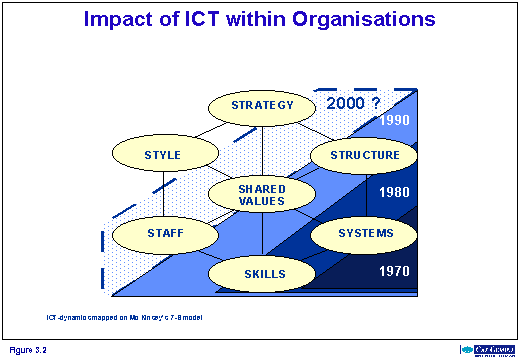
In the seventies IT was but a means of mechanisation. Companies developed their 'bread and butter systems': bookkeeping and payroll-administrations were the common applications of IT.
In the eighties organisations became aware of the need to integrate their applications: the different data-definitions of for instance 'employee' in the separately developed applications for payroll and the wider defined personnel administration caused problems. 'Island-automation' was 'out' and 'Informatisation' was 'in'.
In the nineties organisations became aware of the fact that ICT was a means for the drastic improvement of their business processes. 'Business Process Redesign' became the new buzzword, characterising the drastic impact of ICT on organisational design.
Today ICT has a growing impact on systems, skills, structure and staff and on the shared values of the organisation. Undoubtedly, in the coming decade, the use of ICT will prove to be a strategic dimension of business development and it will drastically impact the style of management.
In the rest of the chapter we give an impression of the transition from IT to ICT and the growing impact of ICT on organisations.
3.2.1 The World-wide ICT infrastructure
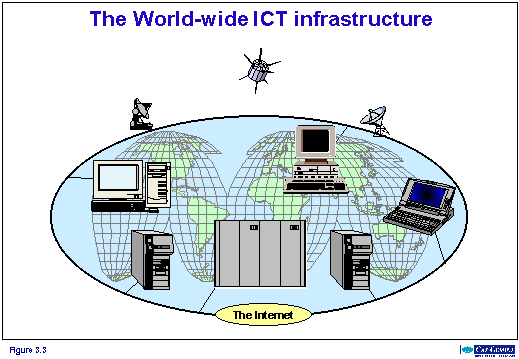
The Internet is currently the most important driving force behind the transition from IT to ICT. Started in the scientific world as a network for e-mail and file transfer the Internet is now becoming the public network for everyone. In recent years we see a spectacular growth of the use and the contents of the Internet. Companies are exploring the business opportunities of the Internet. The Internet owes its popularity to the World Wide Web. WWW is an interconnected collection of information pages, which are placed by organisations and individuals onto server computers. Everyone with a PC and access to the Internet is able to read these pages and follow the links between them.
The Internet is still more used as a global area network (GAN) that connects wide area networks (WAN) and local area networks (LAN) of companies with the home computers of individual people.
The Internet is an impulse for the use of multimedia on the PC. Multimedia is the technology that supports types of information like still images (pictures, drawings), moving images (animation, film or television) and sound. As a result, people are using their PCs more and more for the same purposes as the present day consumer electronics, such as television, radio and CD player. Manufacturers of televisions are developing Web-TV for easy access to the Internet. The future will be home area networks (HAN) that integrate IT, communications and consumer electronics. A home area network has satellites in various rooms, serving for work or entertainment. There are rooms where people can experience virtual reality films or listen to musical renditions. The network handles the energy supply and the climate control of the house and assists in doing the financial accounts.
The miniaturisation of microprocessors combined with the development of cellular networks for mobile communication will lead to the implantation of communicating microprocessors in all kinds of equipment. The mobile telephone gets already new functionality such as a positioning system, connection with an electronic agenda etc. A communicating smart card will replace the credit card. Cars will be equipped with processors that communicate with the driver, control equipment in the road and the global positioning system (GPS). Eventually palmtops and mobile telephones will be replaced by Body Computers (BC) in the form of watches, earrings or implanted chips that act as a body area network (BAN).
The result of current developments is the emergence of a world-wide both wired and wireless network with huge transmission capacity. This network will emerge from an integration of all current forms of telecommunications. These are:
- the Internet and its offspring;
- the telephone network and the cellular networks for mobile communication;
- entertainment networks: radio, television, cable;
- corporate networks.
In the 21st Century this network will act as a global area network that connects computer networks of companies, the home systems of families, the body computers of individual people and the microprocessors of all types of equipment. ICT will have a pervasive and ubiquitous character in our world.
3.2.2 Increasing Reality of Digital Information
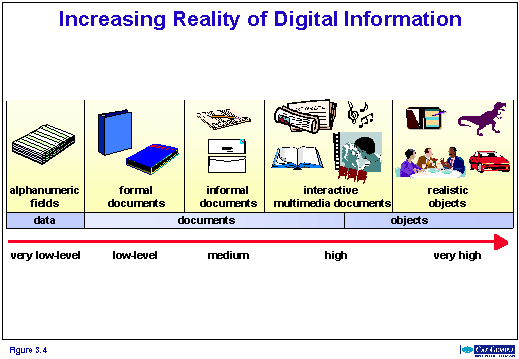
Another important technology trend is the increase in realistic value of digital information. This trend is related to the growing processing capacity of computers and the development of better user interfaces. The terminals of legacy systems and the first generations of PCs were equipped with Character User Interfaces that allow for the presentation of alphanumeric fields and simple text. The major part of the data currently stored in business computer systems consists of these alphanumeric data, with all the restrictions that go with it.
Meanwhile, the Graphical User Interface has become very popular, especially now that most PCs are equipped with Microsoft Windows. With the Graphical User Interface, the user obtains the on-screen presentation of formatted text, drawings and images. The last generation of PCs with Pentium processor allows for the use of multimedia. Users extend their PCs with interfaces for the delivery of stereo sound and video. They also use the PC for telephone or videophone connection through the Internet.
Electronic multimedia documents like an encyclopaedia on CD-ROM contain all forms of electronic data such as text, images and sound. Multimedia documents therefore offer far more possibilities than books, since they not only contain text and drawings but also an interconnected combination of sound, images and video. This matches human vision and hearing in a much better way, which makes multimedia documents highly suitable for knowledge transfer. Multimedia is further supported by a shift from documents to realistic objects. In computer games we use electronic objects with instructions and data for the behaviour and representation of dragons and knights. These objects interact during the game with the player and with each other. Each object by itself knows how to behave: how to act on other objects and how to react when acted upon.
The realistic value of digital information will be even further enhanced over time. The information technology to facilitate this is called virtual reality. Virtual reality focuses on user interfaces that support many human senses in order to let the user experience, a certain situation as realistically as possible.
Virtual reality may contribute significantly to the success of learning processes. People learn best through their own experience. By means of virtual reality, people can gain experience by seemingly living through extreme situations without physical danger. Flight simulators are a good example of professional application of virtual reality.
With virtual reality, people are able to communicate long-distance while seemingly having a personal, face to face conversation. Operators can monitor and control processes from a distance as if they are actually present. Real-life events can be represented true to life after they have happened, or be simulated before they actually happen.
The combination of virtual reality and physical reality is an augmented reality. Just as the telescope and the radar augmented our senses in the past, will virtual reality augment our view on both the structure and dynamics of the physical reality in the future.
3.2.3 A Virtual World Emerges
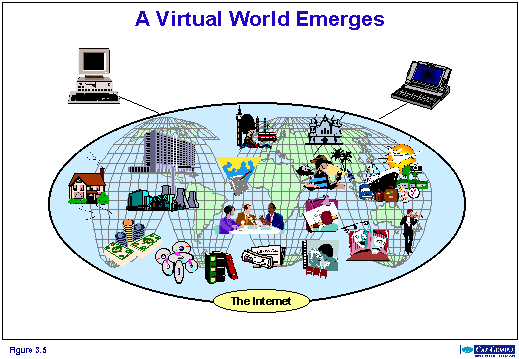
The Internet in combination with multimedia and virtual reality will create a new, virtual world for its users parallel to the real world in which they live physically. Internet users already experience this emerging virtual world.
The Internet creates a virtual world, in which the users communicate with other people and organisations. In the virtual world there are no distances. Through the network, users can reach other people and computers all over the world and therefore have 'ears and eyes' everywhere and have their 'say' everywhere in discussion groups. They can request all kinds of information. They order their personalised CD's, books, man-tailored shirts or model trains from virtual stores or shopping malls. They are home bankers who use videophone to seek advice from bank employees. On the network people can request the schedules of concert halls from all over the world. Tickets to concerts in the neighbourhood can be ordered electronically. In future concerts that are performed at the other end of the world can be attended by means of a live broadcast or a live recording rendered on the home system by their media supplier.
The virtual world on the Internet will change the hours for work and spare time. As a result of the growth towards world-wide networks and partnerships, organisations in the form of virtual companies emerge all over the world. These organisations operate over the Internet 24 hours a day. The social consequences of these changes are unpredictable.
This change especially concerns people who work with information and knowledge. The production of information products is not restricted to a particular location. This work can take place anywhere in the world, at a mobile workstation, a home system or a company system. The resulting products are delivered through the network.
There will of course always remain people who carry out their work at a set location or along a fixed route. For instance people, who produce and transport material products or provide services directed at the physical world, such as maintenance, cleaning and repair work. But as a result of the growing automation and mechanisation, working at permanent locations and at fixed hours will relatively decrease, while the growth of information and knowledge work will lead to an increasing freedom for people to work at any time and at any place.
3.3 ICT enabled Enterprises
The changes in technology cause fundamental changes in how people work together. In the 21st Century a new form of ICT enabled enterprise will emerge. This section gives an overview of some of these changes.
3.3.1 The role of ICT in Communication and Co-operation
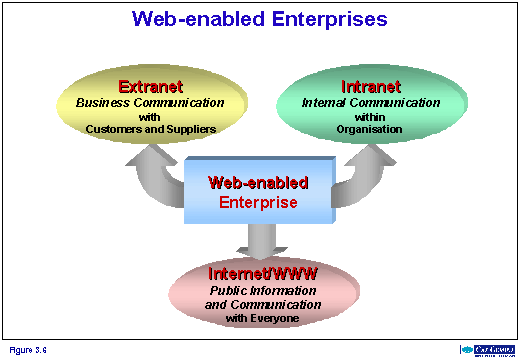
We see nowadays how the first virtual enterprises emerge enabled by Internet and Web technology. The technology supports the external and internal communication of the virtual company in three ways:
- The Internet is used as public network for information and communication to the public and especially to potential customers.
- Internet technology is used for an Extranet. This is a private network for the business communication with customers and suppliers. An Extranet is realised as a communication server within the company, which is accessible through the Internet for authorised users. The communication server offers the user access to information systems and employees within the company.
- Internet technology is used for an Intranet. This is a private network for the internal communication between the employees within the company. The Intranet not only uses Internet and Web technology for the support of communication but also incorporates groupware and workflow applications for the support of co-operation, process control and knowledge exchange.

These new Web-enabled enterprises show that the transition from IT to ICT adds a new dimension to the support that technology offers to the business. The communication technology supports the internal and external communication of the company. The combination with information technology extends this to the support of the co-ordination and co-operation between employees, customers, suppliers and partners.
Communication, co-ordination and co-operation in a company are especially important between two participants, which communicate with each other in the role of customer and supplier. This relation exists between the company and a customer, between a supplier and the company, and also between two employees working in successive steps in a supply chain.
The communication, co-ordination and co-operation occur at three levels:
- Promotion and orientation
When customers need a product or service they usually orient themselves, which suppliers are able deliver the product or service under what conditions. Suppliers therefore offer customers information about their products and services through different channels like advertising in papers, commercials on television, information documents or a conversation between (an employee of) the supplier and the customer.
ICT enables new channels for this orientation and promotion. The Internet and other electronic channels like electronic kiosks are new ways for the exchange of product information. Videophone via the Internet will support remote sales conversations between customers and companies. On the Internet a new type of companies emerges in the role of intermediate between suppliers and customers. These intermediates collect the information about a certain type of product of all suppliers and offer this to the customer. The customer has now an overview of the products of all suppliers. This makes it easy for the customer to compare the different offers.- Buying and selling
After orientation the customer chooses one or more potential suppliers for the delivery of a product or service and asks for a quotation or offering. The customer uses these offerings to decide which supplier may deliver the product or service.
ICT also offers new ways for buying and selling. Internet, electronic kiosks and call centres are currently the new sales channels. Call centre and Internet will merge to one channel with videophone via Internet. The supplier can offer his regular customers access through an Extranet. The Extranet is used for special offers and services to the regular customers.- Production and delivery
The supplier produces the product or service and delivers it to the customer. The support of ICT will totally change the production process. An Intranet with groupware and workflow applications supports the co-operation of employees. Electronic message switching is used for the communication between the automated processes of customers and suppliers. ICT will help to organise a flexible computer-controlled delivery process. This makes it easy to change the pattern of co-operation between employees. The result is the end of the current conveyor-belt mass-production system. ICT supports an agile organisation, which is able to deliver the customer tailored products and services by simply planning and executing the right process pattern for the production and delivery of every individual product.3.3.2 The Growth of the Immaterial Economy
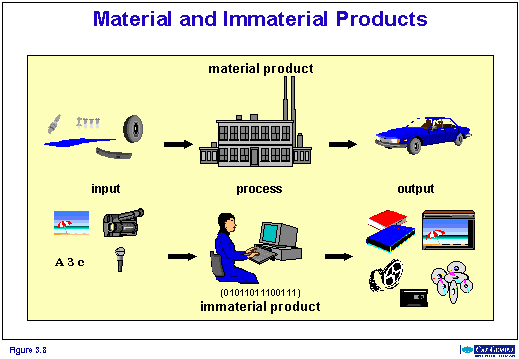
The developments in information and communication technology will strongly influence our economy. Most important is the development of a huge immaterial information economy parallel to our current material industrial economy.
Like the steam engine and the railway in the nineteenth century contributed to the improvement and intensification of material industries, computer and telecommunications will contribute to the expansion of immaterial industries.
In the material world, production processes revolve around the processing of raw materials into material products and around the production of food. In the immaterial world, processes revolve around the processing of information in the form of data. Data are the immaterial 'raw materials' in the production process. Immaterial products are for example the contents of a book, text in a document, sound on a compact disc, representation of data on a monitor. An immaterial product is always a form of information or knowledge for the user. Money lives in both worlds: a coin is material and tangible and the money on a bank account is information and therefore immaterial and intangible. This electronic money is only visible as data on an account overview.
Computers support people in the processing of digital data and the production of information in the form of electronic documents. We 'mechanise' the production of information. This implies an enormous expansion of our capacity to produce all kinds of knowledge and information.
The kick-off of the information industry already happened at the beginning of this century. Radio, television, film and the record industry have grown as a result of the production of immaterial products. When we buy a compact disc, we do not primarily pay for a piece of plastic, but for its immaterial contents: a set of bits arranged in a specific way. We actually pay for the piece of music we hear when a CD player converts the bits into sound.
The development of information technologies such as multimedia and virtual reality will considerably increase the possibilities we have to depict imaginary and experienced realities and to create new and different information products. The price consumers are currently willing to pay for immaterial products like audio-CD, videotapes and computer games on CD-ROM demonstrate that a new source of business has been found.
For media suppliers, the development of the Internet and of home systems opens up new commercial opportunities. Within some years the Internet will have a transmission capacity, which allows them to offer the contents of newspapers, magazines, books, reference manuals, compact discs and radio and television broadcasting in digital form direct via the Internet. Instead of buying a CD, the customer selects a Brahms symphony from the electronic catalogue at home, and orders it from a media supplier in the network. The supplier sees to it that the symphony is sent to the home system of the customer in digital form via the network. The home system renders the symphony from the speakers in the living room. Video on Demand is a first step in this development. Customers do not have to passively watch and listen to what the media suppliers offer them. The supplier provides the products as interactive 'documents'. The users are free to decide in which order they will play the document, to temporarily stop using it or to repeat certain parts. The customer pays for this service. We assume that the customer will basically pay for the use of the documents – the eternal use, if necessary – not for the ownership of the documents. This means that the supplier 'broadcasts' the documents for direct rendition by the home system. He does not 'send' an electronic copy, to be stored and used on the home system. Television and radio broadcasting, as we know it – continuous broadcasting on air and on cable – will eventually disappear. Instead, media suppliers will broadcast on demand information, films and music to the customer's home or mobile system.
Immaterial products become truly immaterial in this way, for the material bearers of data as we know them now, such as books that contain novels, CDs that contain pieces of music or videotapes that contain films, will disappear for the major part. Suppliers of news, information, novels, articles, music, films and educational material will in future represent these immaterial products on their customers' home systems via the Internet.
3.3.3 Knowledge Exchange and Creation
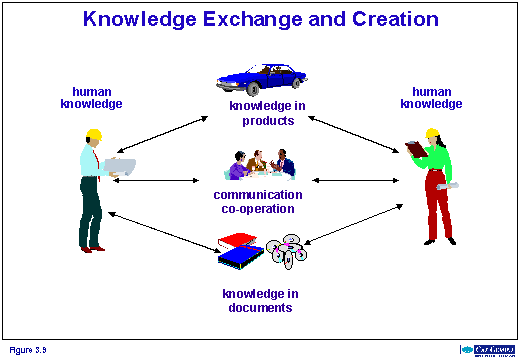
The immaterial and material worlds show a significant relationship. Almost everything that people create in the material world, they have first designed in the immaterial world. With the computer, people are better able to design material products like cars and aircraft and also to design, control and monitor the processes to produce these products.
Communication technology enforces this development by supporting the knowledge exchange between people. In our opinion knowledge is best defined as "knowing how to act". For instance knowing how to make a product, how to deliver a service or how to communicate with people.
People can exchange knowledge in different ways:
- Through face-to-face communication in teams or in workshops.
- Through information in documents. The reader must read this information and internalise it to his/her knowledge. It actually becomes knowledge when the reader applies it successfully in practice.
- Through material products. There is a lot of knowledge creation during the development of a material product. This knowledge is hidden in the product. Car manufacturers test their own (and other manufacturers products) to get information and knowledge about the functioning and construction of the product.
ICT supports al these forms of knowledge exchange:
- Communication technology and virtual reality will support the remote communication between people with a quality near to face-to-face communication. This supports remote communication in the form of virtual workshops, virtual classroom or distant learning.
- Information technology supports new forms of electronic documents. Multimedia and virtual reality are useful technologies in support of knowledge exchange and learning processes.
- ICT strongly enhance the amount of knowledge in the products (both material and immaterial) and in the services of companies. Material products like cars are currently designed and simulated with aid of the computer. A prototype of the car is tested and all test information is assembled and processed by a computer. Developers transform the information into new knowledge, which result in improvements of the car design and the resulting car construction.
ICT enforces a longer existing trend. Better education and more complex products and services have already made knowledge an important economic resource. Supported by ICT knowledge will become the most important economic resource in the 21st Century.
3.3.4 The Web Enterprise
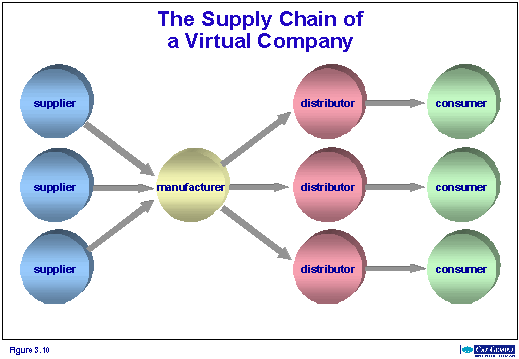
ICT will enable new forms of organisation. The ICT enabled corporation should be structured around supply chain and not follow the traditional functional hierarchy. A supply chain is an end-to-end set of activities, which collectively create a product or service for a customer. Current information systems usually do not support a whole supply chain but individual steps in the process. The applications are vertical "stovepipes" supporting a specific business function. ICT systems are horizontal networks. ICT systems are able to support communication between the employees along the supply chain and the control of the combined production process and support in this way the co-ordination and co-operation in the whole supply chain.
A supply chain may link several companies that produce and deliver a product or service together. This is what we call a virtual company. People, competencies, facilities and capabilities, which are part of different companies, are linked together as though they were one enterprise. ICT is a perfect enabler of virtual companies. ICT helps to assemble and manage resources from different companies so that they behave like resources from a single company.
A classical example of an ICT enabled virtual company is the Italian firm of Benetton. In 1985 this firm introduced a computer network with which it co-ordinates and manages the business processes of different independent companies. The firm has a network of shops all over the world and a lot of small ateliers supply the clothing. The shopkeepers and the owners of the ateliers are independent entrepreneurs. The Benetton head office in Italy co-ordinates the entire organisation. They use a computer network for the world-wide communication and information exchange. This way, Benetton is able to closely follow the sales figures across the entire world. On the basis of sales prognoses and the wishes of customers and shop owners, the firm has the desired types of clothing made in the desired colours. The delivery time of these clothes is very short. The entire Benetton organisation is geared for the flexible production of small series of exclusive clothes, for which there is an evident current demand among the customers.
In the car and aircraft industry we see other examples of virtual companies. Boeing for example uses electronic co-operation in the design and building of a new aircraft. In co-operation with its suppliers, Boeing completely designs the aircraft by means of the computer. As a result of the co-operation, the engineers already make sure that all the components of the aircraft fit during the design phase. This gives them the certainty that the aircraft can actually be built. Customers of Boeing are also involved in the design process. A number of airline companies are co-operating to see whether the aircraft offers the right comfort to the passengers and whether it is easy enough to operate and maintain.
ICT will fundamentally change the way in which people work together. Our current organisational view is determined by the Industrial Revolution. It is focused on division of labour. Divide and simplify the work and let the workers do not think. There is one best way to do the work. The management style is hierarchical. The management gives orders and workers have little effect on quality. The organisation is aimed at lowest cost per worker and standardised work.
The result is a static enterprise. The industrial company tends to focus on mass-production of uniform products at the lowest cost. Not only the manufacturing industry but also the financial industry has flourished by this industrial approach of the organisation.
Even the first ICT enabled virtual companies in the manufacturing industry show still the industrial style. They use ICT for supply chain integration, that is the streamlining and improvement of the common production and transport processes within the supply chain. Results are shorter production time and lower stock levels.
But companies can use ICT for other reasons. Benetton uses ICT enabling for mass-customisation: the massive production of clothes tailored to the wishes of the customers. ICT helps Boeing to master the growing complexity of aircraft design. The growing complexity of a lot of products and services makes it still more difficult for one company to realise a new product or service. Companies have to bundle their competencies in a virtual company in order to design and produce complex products and services. In such a virtual company a number of companies will specialise in producing components, while other companies will focus on combining these components into products customised to the wishes of the customer. The result is both mass-customisation and more complex products.
Virtual companies make the business world as a whole much more flexible and provide it with a greater adaptability. The collaboration between the participants, the patterns of the production process and the resulting products are better tailored to the specific demands of customers.
The result will be that the current large monolithic enterprises gradually transform to Web Enterprises. The Web Enterprise no longer consists of one or more supply chains but offers a supply web in the form of an ICT enabled association of companies and individuals, which is organised to quickly assemble and disassemble virtual supply chains.
The Web Enterprise is:
- Virtual
The Web Enterprise links people, competencies, facilities and capabilities of different companies or individual workers, together as though they are one enterprise.- Agile
The Web Enterprise shows shifting patterns of affiliations, dynamic assembly of core competencies and the resulting virtual supply chains can take many forms.- Adaptive
The Web Enterprise quickly adapts to changes both internally and externally by changing the patterns of co-operation within the enterprise.- Learning and knowledge creating
Knowledge is the primary resource in the Web Enterprise. Information and knowledge exchange supports the learning processes of the employees. The enterprise stimulates the employees to create new knowledge for improvement of products, services, production and delivery.The organisation view of the Web Enterprise is: empower the workers, enrich their work, let them make maximum use of their intelligence and let all workers contribute to enterprise learning and creativity. The new management style is participative. The organisation consists of teams managing themselves by constant communication. Quality is everyone's job. The organisation is aimed at the highest value added per worker and constant evolution of the product and the processes. The result is a learning and self-renewing enterprise.
The Web Enterprise tends to focus on agile production of tailored products with the highest value added. The maximum agility: every individual product has its own virtual supply chain!
We are in the early stages of an historic transition:
- from mass-production to agile production;
- from single-company operations to Web Enterprises;
- from the industrial age with capital, raw materials, land and labour as the primary economic resources to the information age with information and knowledge as the primary economic resources;
- from an industrial organisation in the form of a supply chain acting as a static mechanism to a knowledge-driven organisation in the form of supply web behaving as a living ecosystem.
The result is a new type of corporation: a virtual, agile, adaptive, learning, knowledge creating Web Enterprise, where corporate wealth grows because all employees work smarter.